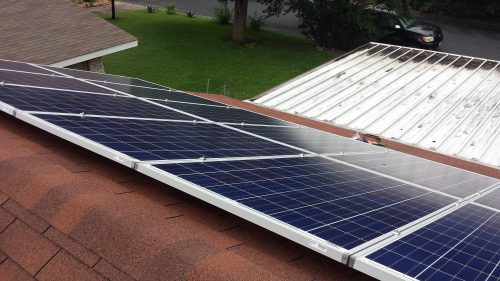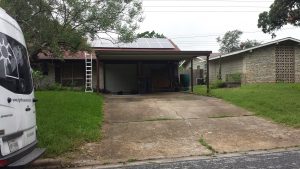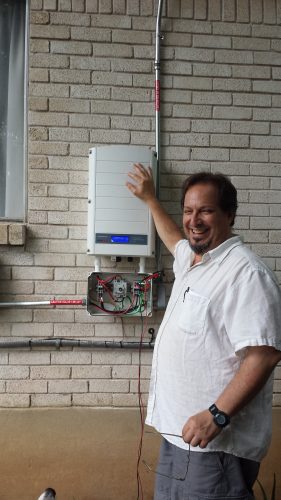by Martin Luecke

WPNA is focusing on the environment this month, so I am combining two columns into one story about building a solar array on your house. The Climate Crisis Committee is working on a Carbon Reduction calculator website and our main goal is to get Windsor Park to reduce it’s collective carbon footprint. Here is one way to achieve that goal: build a solar array.
Once upon a time I was a solar array system installer and worked on many houses around Austin. I have watched the cost of systems drop significantly over the decade as technology has improved. I got a close look in 2014 when my retired neighbors Gary and Bonnie Lockhart built a 4.5 kWH system on Cloverleaf (I profiled Bonnie three years ago). What truly caught my attention was the end of the day cost on building a system, and the fact that it pays for itself in five to seven years, with a 25 year warranty.
Gary and Bonnie worked with Austin Energy to acquire all the various rebates available from the city, along with the 30% federal tax credit. “It was easy to do” Gary says matter of factly. Six years later he is extremely happy with his system, that it has never given him one problem or required any maintenance. And now in year seven it generates income. “It’s money in the bank” Gary smiles. “It’s great.”

A few blocks away on Coventry Lane Selwyn Polit has similar reports. Selwyn is a website developer and serves on our Climate Crisis Committee. His 4.75 kWH system was installed in 2015. “The first thing you do is weatherize your house.” Most houses need attic insulation upgrades, but it can include your a/c ducts and doors and windows. The idea is to improve your house in every way possible to save energy. Solar is just another way of saving energy, and ultimately reducing your carbon footprint.
The Lockharts paid for their system at the time of installation, which garnered them the greatest amount of rebates and tax credits. Selwyn opted for a solar loan, which is exactly what it sounds like. He has a 20 year fixed rate loan with a payment of $72 a month, which included all costs and services involved with weatherizing and system installation, and also had significant rebates from Austin Energy. Selwyn says his electric energy costs have been cut in half and is in fact paying for the loan in savings. He says his only mistake was not getting a larger system to cover 100% of his energy needs. He is shopping to increase the size of his system now.
Consumer Reports suggests that you could finance your solar panel purchase with a home equity loan. Because your house serves as collateral you can get low interest rates (currently 3 to 5 percent). There is also a home equity line of credit available, and a new thing called Solar Leasing which requires no money from the homeowner. Consumer Reports advises against leasing because the homeowner can potentially lose control of their roof.
“Every home in Austin is a snowflake and unique” bubbles Marta McDougle when talking about getting rebates for installing solar. Marta works in the Energy Efficiency Services office, also known as the Rebate Department at Austin Energy. “We have rebates for all kinds of things: pool covers, chicken coops, rain catchment” Marta explains. “We provide rebates for upgrades on home performance. For example we give a 25% rebate for the cost of insulation.” Today Austin Electric’s solar rebate is capped at $2500. Marta then makes the important point: the city pays 9.7 cents per kWH you produce, which is subtracted from your monthly statement. The question is: how many kWH do you want to produce? Gary and Selwyn both want to add more panels.

Selwyn says he has needed only one maintenance job in five years, but when he was looking at his system readout during our interview he realized one of his 19 panels is not online and will require some work. The warranty is complicated by the many different electrical parts involved. Some things have 25 years, others have 20, and service fees are not covered after five years, although parts will be free. Marta advises to call three companies and go through the bid process to compare systems, warranties, and prices.
One major effect of having a solar array is the owner becomes very aware of their energy usage, which naturally makes them conserve energy. The graph shows Selwyn’s four year history of energy consumption and production and it’s a testament to the idea of each person being responsible for their carbon footprint. Selwyn has produced 26 Megawatt Hours of energy in that time, and saved more than 38,000 pounds of CO2, which is equal to not driving 55,000 miles. Our personal reduction of energy use and creation of renewable energy are major parts of dealing with the climate crisis.
Contact me with story ideas: mwluecke@hotmail.com 512.536.0465






 Seven of our eleven 2023 Scholarship recipients being recognized at our June WPNA meeting.
Please support our scholarship effort by contributing below through our secure PayPal site.
Seven of our eleven 2023 Scholarship recipients being recognized at our June WPNA meeting.
Please support our scholarship effort by contributing below through our secure PayPal site.



